 klaus-michael schneider
klaus-michael schneider
Keywords: education |
Links: FOTW homepage | search | disclaimer and copyright | write us | mirrors

FOTW beschäftigt sich mit der Wissenschaft der Vexillologie (Flaggenkunde).
Alle auf dieser Website dargebotenen Abbildungen dienen ausschließlich der Informationsvermittlung im Sinne der Flaggenkunde.
Wir distanziert uns ausdrücklich von allen hierauf dargestellten Symbolen verfassungsfeindlicher Organisationen.
Last modified: 2021-05-22 by  klaus-michael schneider
klaus-michael schneider
Keywords: education |
Links: FOTW homepage |
search |
disclaimer and copyright |
write us |
mirrors
![[Flag of Colombia]](../images/c/co.gif) (2:3)
(2:3)  image by Željko Heimer, 20 May 2001
image by Željko Heimer, 20 May 2001
See also:
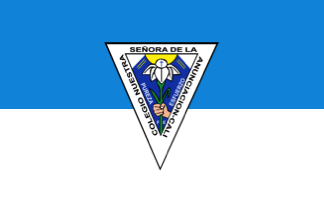 image by Ivan Sache, 1 January 2021
image by Ivan Sache, 1 January 2021
Colegio Nuestra Señora de la Anunciación (CONSAC) is located in Cali (Valle
del Cauca).
The flag of CONSAC is horizontally divided celestial
blue-white with the school's emblem in he center.
Blue conveys the
message delivered by Our Lady of the Annunciation, which protects the CONSAC
educational community.
White is a symbol of integrity, honesty, simplicity
and sincerity, the values to be sown in the mind and heart of each student. It
teaches to each student to live in faith, generosity and sacrifice, Mary's
proper virtues in the moment of the angel's Annunciation.
The emblem's
triangular shape means unity in diversity. The school's monogram is enclosed in
a double triangle, indicating the best education for the town's youth.
The
lily in the center is Mary of the Annunciation, a symbol of purity, generosity,
sacrifice, humility and simplicity. Every student at the school shall be
educated to these virtues, on Mary's example.
The lily is surmounted by the
host, emphasizing the school's educational philosophy based on the Christian
principles of faith, hope and love.
The sun of wisdom broadens the horizons
of knowledge and inundates with its light every student of the school.
https://laanunciacioncali.edu.co/nuestros-simbolos
School website
Ivan Sache, 1 January 2021
 image by Ivan Sache, 3 January 2009
image by Ivan Sache, 3 January 2009
"Colegio Parroquial Nuestra Señora de
Chiquinquirá" was founded in 1964 by Priest Ernesto
Villegas in Bello, a municipality part of Greater Medellín,
Department of Antioquia. The institute is named after the
patroness of Colombia, Our Lady of the Rosary (see: <www.churchforum.org
>).
The flag and coat of arms of the institute were created by Sister
Teresita Mora in 1973.
The flag, as shown graphically on the website
of the institute, is blue with a white stripe in the middle,
a "cristofer" (Cross of Lorraine) in its left part and
three stars in its right part, all white. Blue and white are the
Marian colours.
From the drawing, it can be guessed (but not ascertained) that
the white stripe follows the ascending diagonal. The location and
size of the charges are not straightforward: the stars,
representing science, virtue and life, seem to be four-pointed,
in increasing size from left to right; on the coat of arms,
however, they are of equal size, five- pointed and
placed along the ascending diagonal. The "cristofer"
represents the Archbishopric (I guess, of Medellín).
On the website of the institute, the image of the coat of arms is
much less ambiguous than the image of the flag, which seems to
have been directly derived from the shield, and should,
therefore, have the same graphical characteristics.
Ivan Sache, 3 January 2009
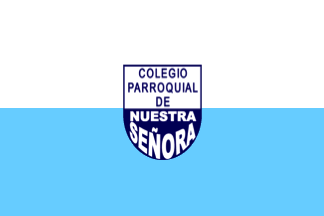 image by Ivan Sache, 12 October 2018
image by Ivan Sache, 12 October 2018
Colegio Parroquial de Nuestra Señora (CPNS) was established on 11 February
1962 in the Quiroga borough (Bogotà) by Father Guillermo Agudelo Giraldo.
The
flag of CPNS is horizontally divided white-celestial blue with the school's coat
of arms in the center.
http://colegioparroquialdenuestrasenora.edu.co/simbolos/
CPNS website
Ivan Sache, 12 October 2018
 image by Ivan Sache, 4 February 2009
image by Ivan Sache, 4 February 2009
"Instituto Nuestra Señora del Amparo" (INSA) was
founded in Bogotá by the Congregation of "Dominicas Hijas
de Nuestra Señora de Nazareth" (Dominican Daighters of Our
Lady of Nazareth). The congregation, founded on 25
March 1938 by Mother Maria Sara Alvarado Ponton (1902-1980) and
Friar Enrique Alberto Higuera Barrera (1906-1976), was
canonically recognized by the Holy See on 8 September 1975.
The flag of the institute, as described on the webpage of
the institute, is horizontally divided white-green. White
represents the devotion to the Blessed Virgin, translated as an
invitation to live in purity and to build a pacific society.
Green represents the aspiration to a better world and the
significance of ecology for the students.
Ivan Sache, 4 February 2009
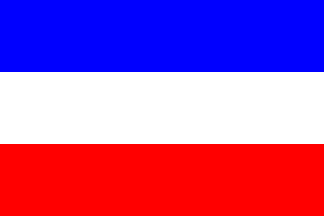 image by Ivan Sache, 28 September 2014
image by Ivan Sache, 28 September 2014
Institución Educativa Nuestra Señora de Belén is located in the Belén
borough, part of the municipality of Cúcuta (Norte de Santander Department).
The flag of the institute is horizontally divided blue-white-red. Blue is the
colour of the cloak of the Blessed Virgin. White is a symbol of the purity of
heart. Red is a symbol of fire and life.
Source:
http://www.colnubelen.edu.co/index.php?option=com_content&view=article&id=30&Itemid=94
- Institute's website
Ivan Sache, 28 September 2014
 image by Ivan Sache, 03 November 2014
image by Ivan Sache, 03 November 2014
Escuela Normal Superior Nuestra Senora de Incarnación originates in a small
school established in Pasca (Cundinamarca Department) in 1959 by the parish
priest, Jaime Hincapié Santamaría (1914-2005). Escuela Normal Superior Nuestra
Senora de Incarnación was eventually established by Resolution No. 374 of 23
February 1999.
The flag of the institute is horizontally divided white-dark blue. White is a
symbol of purity and transparency. Blue is a symbol of the immensity of heavens.
White and blue are the colours of the cloak of Our Lady of the Incarnation, the
patron saint of the municipality of Pasca and of the institute.
Source:
http://normaldepasca.edu.co/?page_id=33 - Institute's website
Ivan Sache, 03 November 2014
 image by Ivan Sache, 12 July 2014
image by Ivan Sache, 12 July 2014
Institución Educativa Nuestra Señora del Carmen is located in La Dorada
(Caldas Department).
The flag of the institute is red with a blue
triangle that had vertices in lower hoist, lower fly and midpoint of the upper
edge. The institute's emblem is placed in the upper part of the blue triangle.
The emblem of the institute follows the same pattern, with yellow
charges: a lily in the blue field, a lamp in upper hoist and a star in upper
fly. The motto of the institute reads "VIRTUD CIENCIA" (Virtue Science).
http://wwwprofesdeiensec.blogspot.fr/p/colegio.html - Student's blog
Ivan Sache, 12 July 2014
 image by Ivan Sache, 21 June 2014
image by Ivan Sache, 21 June 2014
Colegio Integrado Nuestra Señora de las Mercedes (Colmercedes), located in
Lebrija (Santander Department), was established in 2002 as the merger of Colegio
Nuestra Señora de las Mercedes, Centro Educativo Piloto Cuzamán and another ten
rural schools from the neighbouring villages.
The flag of the institute is horizontally divided white-dark green. White is a
symbol of [...] (the missing word in the source must be "peace"). Dark green is
a symbol of hope, aspiration to surpassing, and reconciliation with the natural
environment.
Source:
http://colmercedeslebrija.edu.co/sitio/nuestra-institucion/82-simbolos.html
- Institute's website
Ivan Sache, 21 June 2014
 image by Ivan Sache, 9 October 2018
image by Ivan Sache, 9 October 2018
Colegio Integrado Nuestra Señora de la Paz was established in Tienda Nueva,
settlement La Putana, Betulia (Santander Department) by Decree No. 324, signed
on 5 December 2001 by the Governor of Santander.
The flag of Colegio
Integrado Nuestra Señora de la Paz is horizontally divided white-blue-green.
White represents peace, the main goal of the country, also alluding to the name
of the institute (Our Lady of Peace).
Blue represents the water resources of
the region and highlights river Sogamoso as a source of life, growth, hope and
prosperous future.
Green represents the natural resources of the region and
its dedication to agriculture.
http://www.colpazbetulia.edu.co/index.php/page/item/32
School website
Ivan Sache,
9 October 2018
 image by Ivan Sache, 27 June 2014
image by Ivan Sache, 27 June 2014
Colegio de Nuestra Señora de La Presentación - Centro was established
on 19 March 1877 in Bogotá by the Dominican Sisters of the
Presentation, a congregation founded in 1695 by Marie Poussepin
(1653-1744; beatified on 20 November 1994 by Pope John Paul II).
Among the famous alumni of the institute are the politicians Eduardo
Santos Montejo (1888-1974), 21st President of the Republic of
Colombia (1938-1942) and Carlos Sanz de Santamaría (1905-1992), Mayor
of Bogotá (1942-1944), Colombia Ambassador to US (1945-1946;
1960-1962), Permanent Representative of Colombia to the United Nations
(1982-1983), and Minister of Economy (1944-1945), of Finance (1945;
1962-1964), of War (1946-1947), and of Foreign Affairs (1957-1958),
and the Jesuit Father Félix Restrepo Mejia (1887-1965), Rector of the
Pontificia Universidad Javeriana and renovator of the Colombian
Academy of Language.
The flag of the institute is horizontally divided blue-white-blue.
Source:
http://www.colprecentro.com/index.php?option=com_wrapper&view=wrapper&Itemid=10 - Institute's website
Ivan Sache, 27 June 2014
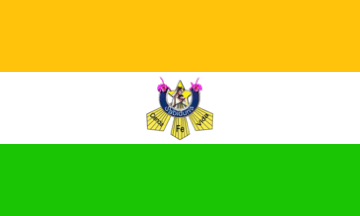 image by Ivan Sache, 1 February 2009
image by Ivan Sache, 1 February 2009
"Instituto Nuestra Señora de la Sabiduría para Niños
Sordos" (for deaf children) was founded by a French nun,
Mother Ives del Sagrado Corazón de Jesús, in San Juanito,
Department of Meta, on 17 March 1924. This was the first attempt
of specific education for deaf children in Colombia. President of
the Republic Eduardo Santos Teniendo Conocimiento ordered the
transfer of the institute to Bogotá, which was completed on 8
May 1940.
The institute is ran by sisters of the Congregation of the
Daughters of Wisdom, one of the three branches of the Montfortian
family. The three congregations originate in the Company of Mary,
founded by St. Louis-Marie Grignon de Montfort (1673-1716,
canonized in 1947), who has remained famous for his devotion to
the Blessed Virgin.
The flag of the institute, as video-presented and described on
the website of the
institute, is horizontally divided dark (lit.
"burned") yellow-white-green with the emblem of the
institute in the middle. The dimension of the real flag is 2.50 m
x 1.50 m.
Yellow represents the belonging to the universal church and the
spiritual and philosophical resources of the Montfortian
spirituality.
White symbolizes simplicity, peace, truth and the virtues that
transcend all the acts in the life and allow the actions of the
educational community.
Green represents the commitment to conservation and preservation
of natural resources as well as hope.
The emblem of the institute, presented in the same way, is made
of a yellow star charged with an icon of the Blessed Virgin,
surmounting a King blue scroll charged with "Sabiduria"
(Wisdom) in white letters and ending with two pink orchids, from
which emerge three rays of yellow light charged with
"Ciencia" (Science), "Fe" (Faith) and
"Vida" (Life), respectively, all in black letters.
Blue is the symbol of happy life, dynamism, youth and search of
happiness through daily meetings with Jesus' wisdom.
Ivan Sache, 1 February 2009
 image by Ivan Sache, 3 February 2009
image by Ivan Sache, 3 February 2009
The Congregation "Hijas de Nuestra Señora de las
Misericordias" (Daughters of Our Lady of Mercy) was founded
on 11 October 1951 in Santa Rosa de Osos, Department of
Antioquia, by His Grace Miguel Ángel Builes Gómez, Bishop of
Santa Rosa de Osos. The congregation has today 30 houses in nine
countries.
The Congregation runs two educational institutes in Colombia,
"Collegio Técnico Nuestra Señora de las
Misericordias" in Santa Rosa de Osos and "Collegio
Nuestra Señora de las Misericordias" in Soacha, Department
of Cundinamarca.
The flag of the congregation, as shown graphically on the website of the
congregation, is horizontally divided white-light blue, the
traditional Marian colours.
Ivan Sache, 3 February 2009
 image by Ivan Sache, 05 July 2011
image by Ivan Sache, 05 July 2011
"Institución Educativa Nuestra Señora de las Nieves" was founded in
Guaitarilla (Nariño Department) by the priest Bernardo Arevalo Bolaños
(1926-2006).
The flag of the institute is shown graphically and described on the institute's
blog as horizontally divided yellow-red with a white triangle placed along the
hoist. Yellow represents the richness of knowledge. Red represents love,
commitment, energy and strength. White represents innocence, peace and
tranquility of our youth.
Source:
http://insenguaitarilla.blogspot.com/2010/06/simbolos-de-la-institucion.html
Ivan Sache, 05 July 2011
 image by Ivan Sache, 24 September 2014
image by Ivan Sache, 24 September 2014
Liceo Nuestra Señora de las Nieves is located in Bogotá.
The flag of the institute is horizontally divided white-red.
Photos:
http://liceolasnieves.edu.co/index.php/galeria/category/2-25-años-liceistas
Ivan Sache, 24 September 2014
 image by Ivan Sache, 07 October 2014
image by Ivan Sache, 07 October 2014
Colegio Nuestra Señora de Nazareth is a girl's school established in Bogóta.
The flag of the institute is horizontally divided celestial blue-white-celestial
blue (1:2:1). Blue and white are the colours of the cloak of the Immaculate
Virgin. They represent also the two pillars of the institute, Mary and the
Eucharist. Blue is the colour of immensity and deepness. White, the colour of
light, is a symbol of purity, humility, and sincerity.
Source:
http://www.colegionazareth.edu.co/index.php/colegio/emblemas#nuestra-bandera
- Institute's website
Photos:
http://www.colegionazareth.edu.co/images/com_fwgallery/files/186/obrasnazasep2713-48.JPG
http://www.colegionazareth.edu.co/images/com_fwgallery/files/186/obrasnazasep2713-34.JPG
Ivan Sache, 07 October 2014
"Colegio de
Nuestra Señora del Pilar - Chapinero" is managed in Chapinero, Bogotá, by the
Sisters of the Charity of St. Ann, a congregation founded in 1804 in Saragossa
(Spain) by Father Juan Bonal and Mother María Rafols. The institute, founded on
3 October 1949 by Mothers Julia Nasarre and Felisa Esandi, is dedicated to Our
Lady of the Pilar, enshrined in Saragossa by the basilica of the same name.
The flag of the institute (photo shown on the institute's website) is white
with, in the middle, the coat of arms of the Sisters of the Charity of St. Ann,
surrounded by the name of the institute ("COLEGIO NTRA SRA DEL PILAR") and
surmounting "BOGOTA". The writing are in golden archaic letters. White is a
symbol of purity.
Source:
http://www.colpilarch.edu.co/index.php/simbolos-del-colegio/la-bandera
The coat of arms of the Sisters of the Charity of St. Ann is the former coat of
arms of the Royal General Hospital of Our Lady of Grace, located in Saragossa.
On 27 October 1923, Mother Pabla Bescós required the authorization to use the
former arms of the Hospital for the Order, which was granted "without any
inconvenience" on 18 March 1924 by the Ministry of Justice. The lilies in the
jar shown on the arms date back to the Christian Reconquest of Spain. In 1044,
King of Navarra García found in Nájera a statue of the Virgin hidden in a cave,
placed beside lilies in a clay jar. To celebrate the miracle, the king set up
the Order of Chivalry of the Terrace, the oldest founded by kings in Spain,
whose emblem would be a lilies in a clay jar, the whole on a white background,
symbolizing the mystery of Incarnation. It became then common in Spain to
represent in cathedrals Angel Gabriel saluting the Virgin with a vase of lilies.
In 1403, Infante Ferdinand of Castile renewed this usage, asking his sons to
bear the jar emblem. His son Alfonso V founded in 1425 the Royal Hospital, which
was granted arms with the lilies in the jar. María Rafols and the first sisters
who served in the Hospital used this emblem on their cloth; when the cloth was
modified in 1969, the lilies in the jar and the crucifix were kept.
Source:
http://www.colpilarch.edu.co/index.php/simbolos-del-colegio/el-escudo
Ivan Sache, 28 July 2011
 image by Ivan Sache, 08 July 2011
image by Ivan Sache, 08 July 2011
"Institución Educativa Nuestra Señora del Pilar" is located in ?.
The flag of the institute, as shown (photo) and described on the students' blog
as horizontally divided emerald green-ruby red-gold yellow-ruby red-emerald
green. Green represents hope. Red represents love and fraternity, as well as
victory and joy.Yellow represents ingenuity, creativity and intelligence.
Source:
http://lentecolpilar.wordpress.com/2011/03/21/simbolos-institucionales/
Ivan Sache, 08 July 2011
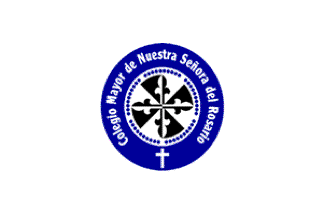 image by Ivan Sache, 6 January 2009
image by Ivan Sache, 6 January 2009
"Colegio Mayor de Nuestra Señora del Rosario" was
founded in 1654 in Arrayanes by the Dominican Friar Cristóbal de
Torres, with permission of King of Spain Philip IV. Torres
redacted the same year the "Constitutions" of the
institute, based on those set up for the famous institute of
Salamanca. Still forming the legal basis of the institute, the
Constitutions were amended only a few times, in 1893, 1930, 1974,
1984 and 1995.
The flag of the institute, according to a photo available on the website of
the institute, is white with the emblem of the institute in
the middle.
The emblem is made of the Cross of Calatrava, which is the emblem
of the Dominican Order, surrounded by a rosary made of five
groups of ten small blue grains each, inscribed in a wide blue
ring charged with the name of the institute in white letters and
a white Latin cross at the bottom of the ring. Designed by Father
Torres, the original emblem has been submitted to various changes
all over the history of the institute.
Ivan Sache, 6 January 2009
 image by Ivan Sache, 13 May 2021
image by Ivan Sache, 13 May 2021
Colegio Parroquial Nuestra Señora de la Valvanera (COPAVAL) was established in 1952 by Father Joaquín García Ordóñez, parish priest of La Valvanera (Bogotá), who served as its rector until 1960.
The flag of COPAVAL is horizontally divided yellow-white-yellow (1:2:1).
Sources: school symbols webpage this photo
Ivan Sache, 6 January 2009
Hosted by: Fanshop-Online.de und Handy-Shop.de
Tipp: Apple iPhone 12 im Shop